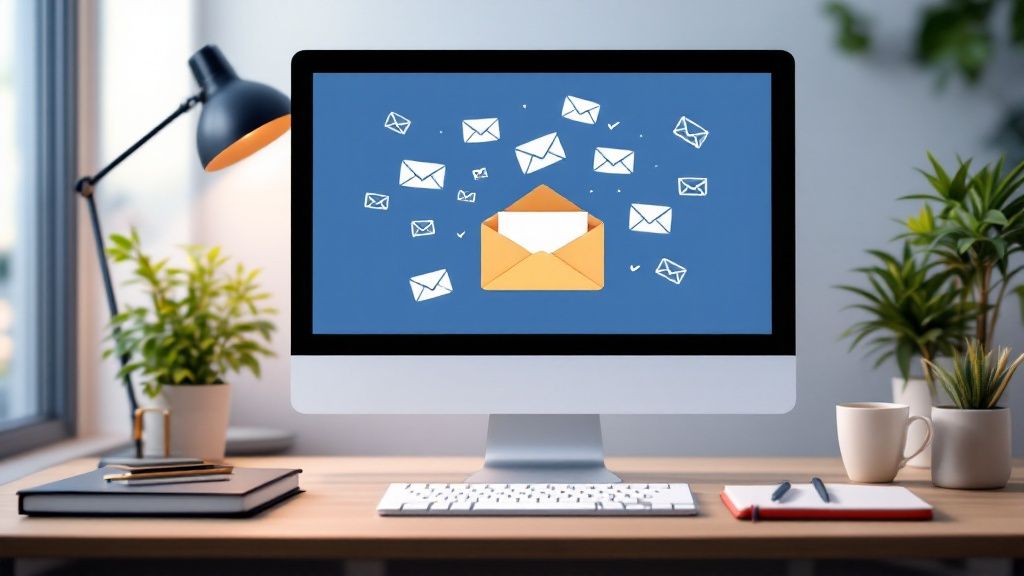How to Improve Email Deliverability: An In-Depth Expert Guide for Modern Marketers
February 21, 2025

Understanding the Real Impact of Email Deliverability

Email deliverability requires more than just sending emails. Your messages need to reach inboxes rather than spam folders to make a real business impact. When your emails consistently land in primary inboxes, you'll see better open rates, more clicks, and increased sales. Poor deliverability, on the other hand, can seriously hurt your marketing results.
The Cost of Poor Deliverability
Emails that end up in spam folders waste your marketing efforts. Important announcements about new products, special offers, or company updates never reach your customers. Beyond lost sales opportunities, this damages trust – if customers expect to hear from you but don't receive your messages, they may see your company as unreliable.
Beyond Delivery Rates: The Importance of Inbox Placement
A good delivery rate tells only part of the story. An email can be delivered to a server but still miss the inbox entirely. That's why inbox placement matters so much – your messages need to land where people actually look. Getting emails into primary inboxes requires building sender reputation, following email best practices, and sharing worthwhile content.
The Role of Authentication in Deliverability
Email authentication protocols play a key role in getting emails delivered. Tools like DMARC (Domain-based Message Authentication, Reporting and Conformance) verify that senders are legitimate and allowed to use their sending domains. This protects against phishing and shows email providers your messages can be trusted. According to recent data, DMARC adoption grew by 11% in 2024, with 54% of email senders now using it. Learn more about email deliverability trends. When you combine proper authentication with engaged subscribers and quality content, you create a strong foundation for email marketing success.
Building an Engaged Subscriber Base That Actually Converts

Your email list represents more than just collected addresses – it's a key driver of email deliverability success. When subscribers actively open and engage with your emails, it signals to inbox providers that your content is valuable and relevant. This positive engagement directly impacts your sender reputation and inbox placement.
The Power of Permission
Permission-based marketing forms the foundation of a strong subscriber base. By getting explicit consent before adding people to your list, you demonstrate respect for privacy while attracting genuinely interested subscribers. Consider offering valuable incentives like exclusive content or special discounts in exchange for email signups. This approach naturally minimizes spam complaints and unsubscribes while boosting engagement.
Segmenting for Success
List segmentation takes engagement to the next level by dividing subscribers into targeted groups based on their specific traits and behaviors. By creating segments around demographics, purchase history, and site activity, you can craft messages that resonate with each group's unique interests. More relevant emails lead to better open and click rates, strengthening your overall sender reputation.
Reactivating Dormant Subscribers
Over time, some subscribers may become inactive. Before removing them, try implementing a re-engagement campaign to win them back. Send targeted emails with exclusive offers, fresh content, or reminders about your value proposition. For more ideas on improving engagement, check out our guide on Boosting your email marketing conversation rates.
Maintaining List Hygiene
Regular list maintenance is essential for strong deliverability. Remove invalid addresses, spam traps, and consistently unengaged subscribers to protect your sender reputation. A clean list focused on engaged subscribers not only improves inbox placement but also increases the likelihood of conversions. Learn more about optimizing your email program in our guide on How to master email marketing automation.
Creating Content That Drives Meaningful Engagement

Growing your subscriber list is essential, but keeping those subscribers actively engaged is what truly improves email deliverability. Think of email marketing like having a conversation – it only works when both sides participate. When subscribers don't open, click, or reply to your emails, inbox providers may start flagging your messages as unwanted.
Understanding Subscriber Psychology
Successful email marketing goes beyond just writing good copy. It requires understanding what makes subscribers want to engage with your messages. Personalization makes a real difference – but it needs to go deeper than just using first names. Consider grouping subscribers based on their past purchases and website behavior to send more relevant content.
Optimizing Send Times for Engagement
When you send emails can significantly impact how many people engage with them. Just like fishing, timing is everything – you want to reach subscribers when they're most likely to be checking their inbox. Study your engagement data to find the times when your audience is most active and responsive.
Crafting Email Experiences That Subscribers Value
The key to maintaining high engagement is creating emails your subscribers genuinely want to receive. Focus on delivering value in every message through:
- Exclusive content and insider tips
- Special offers and deals
- Custom recommendations based on interests
- Mobile-friendly design, since most people read email on phones
Examples of High-Performing Email Campaigns
Top email marketers use several proven techniques to drive engagement:
- Smart Personalization: Using subscriber data to tailor content to individual interests and needs
- Interactive Elements: Adding polls, quizzes, and animated content to make emails more engaging
- Clear Call to Actions: Using direct, compelling language that guides subscribers toward taking action
By implementing these approaches thoughtfully, you can create emails that not only land in inboxes but also get opened, read, and clicked. Remember – engaged subscribers are far more likely to become loyal customers over time. Make every email count by focusing on what provides genuine value to your audience.
Mastering the Technical Foundation of Deliverability

Strong email deliverability requires both engaging content and reliable technical setup. When your technical foundation is solid, email providers trust your messages and deliver them successfully. This section covers the key authentication protocols and steps for implementing them effectively.
Understanding Email Authentication Protocols
Email authentication works like a digital ID card for your emails – it proves they really came from you and weren't modified in transit. This verification helps keep your messages out of spam folders. Three main protocols work together to protect your emails:
-
SPF (Sender Policy Framework): Acts as a bouncer by listing which mail servers can send email from your domain. This stops others from impersonating your domain, similar to checking IDs at a door.
-
DKIM (DomainKeys Identified Mail): Applies a unique digital signature to each email to verify its contents weren't changed. It's like sealing an envelope – any tampering would be obvious.
-
DMARC (Domain-based Message Authentication, Reporting & Conformance): Builds on SPF and DKIM by telling email providers what to do with failed authentication. You can set rules to reject suspicious emails or mark them as spam.
Implementing Authentication Protocols
While setting up these protocols takes some work, it's essential for good email delivery. Most email platforms provide tools to help with the process.
-
Work With Your IT Team: Get your IT department involved early. They'll help set up the DNS records needed for SPF, DKIM and DMARC. Clear communication makes implementation smoother.
-
Use Your Email Platform's Resources: Major email service providers offer guides and sometimes automated setup tools for authentication. Take advantage of their documentation and support.
-
Test Everything: After setup, verify that all protocols work correctly. Use testing tools to check your DMARC, DKIM and SPF records and confirm proper configuration.
Maintaining Technical Excellence
Technical maintenance is ongoing work. Regular checks help maintain strong deliverability:
-
Review Settings Regularly: Check your authentication setup periodically, especially after changing email systems or sending practices. Make sure everything still works as intended.
-
Keep Up With Standards: Email authentication best practices change over time. Stay informed about updates to protect your sender reputation and inbox placement.
A strong technical foundation protects your email program and helps more messages reach the inbox. When combined with good content and an engaged audience, proper authentication sets you up for successful email marketing. Regular maintenance of these technical elements helps ensure consistent delivery over time.
Building and Protecting Your Sender Reputation
Your sender reputation works like a credit score for your email program – it determines whether your marketing emails reach the inbox or land in spam. Email providers use complex systems to evaluate senders and decide where their messages should go.
Understanding How Inbox Providers Evaluate Senders
Email providers look at several key factors when assessing senders. They analyze your email authentication, the quality of your subscriber list, and most importantly, how subscribers interact with your emails. Strong open rates, click rates, and replies signal that recipients value your content. However, high spam complaints and bounces can seriously damage your sending reputation.
Monitoring Your Sender Reputation
To maintain good email delivery, you need to keep track of important metrics like your bounce rate and spam complaint rate. Many email platforms provide tools to check your sender score – a number that reflects your reputation. Regular monitoring helps catch problems early so you can fix them quickly.
Proactive Strategies for Maintaining a Positive Reputation
Building and keeping a strong sender reputation takes consistent effort. You might be interested in: How to master email marketing best practices for increased ROI. Using double opt-in ensures your list only includes genuinely interested subscribers, which reduces spam complaints. Sending targeted content to segmented lists keeps engagement high. Regularly removing inactive and bounced addresses shows email providers you follow best practices. Taking action before delivery issues occur is essential for email marketing success.
Advanced Strategies for Deliverability Excellence
Going beyond basic email marketing requires thoughtful implementation of proven strategies used by successful senders. This involves using data analysis, systematic testing, and behavioral insights to enhance your email program's performance.
Engagement-Based Segmentation: Beyond the Basics
Engagement-based segmentation takes subscriber grouping to the next level. Rather than just using demographics, this approach analyzes how subscribers interact with your emails. For example, you might identify subscribers who open newsletters regularly but rarely click product links. This insight allows you to create messages specifically designed to boost click-through rates for that group, which improves overall engagement and sends positive signals to email providers.
Smart Testing Methods: A Scientific Approach
Modern email marketing requires thorough testing beyond just subject lines. Leading marketers test everything from delivery timing and preview text to email design and button placement. By carefully tracking results, you can identify what gets the best response from different subscriber groups. Think of it like tuning an instrument – small adjustments based on data lead to significantly better performance.
Using Subscriber Behavior Data: Understanding Patterns
Email platforms now provide detailed data about how subscribers engage with messages. This information reveals important patterns. For example, if someone consistently opens emails within an hour of delivery, you can optimize send times for that subscriber to increase the chances they'll see and engage with your content.
Dynamic Content and Strategic Re-engagement
Dynamic content personalizes emails based on subscriber data in real-time. This includes showing products based on browsing history or providing customized recommendations. This targeted approach helps maintain engagement and boosts response rates. Additionally, carefully planned re-engagement campaigns with personalized offers can help reactivate inactive subscribers before they become permanently disengaged.
By putting these advanced techniques into practice, you'll move beyond basic inbox placement to build an email program that delivers real business results. Success shows up in strong inbox placement, higher engagement metrics, and increased conversion rates.
Ready to improve your email marketing and automation workflows? Checkout Links helps Shopify merchants create customized shoppable links, recover abandoned carts, and boost conversions. Learn more about how Checkout Links can elevate your email program.
 Checkout Links
Checkout Links



